E-Learning Report: Analysis of Systems and Strategy for Improvement
VerifiedAdded on 2020/05/16
|11
|2287
|131
Report
AI Summary
This report provides a comprehensive analysis of e-learning, exploring its evolution from traditional classrooms and its increasing accessibility. The report examines the advantages of e-learning, such as flexibility, cost-effectiveness, and the ability to learn at one's own pace, while also acknowledging the disadvantages, including the need for self-discipline and the lack of human interaction. The report is based on personal experiences with various e-learning systems, including Coursera, and discusses the use of virtual classrooms, tutorial videos, and communication tools. Furthermore, the report proposes an e-learning strategy that emphasizes market analysis, tailored content, user-friendly interfaces, and diverse marketing approaches to ensure the effectiveness and growth of e-learning systems. The conclusion highlights the potential of e-learning as a valuable tool for knowledge acquisition and professional development.
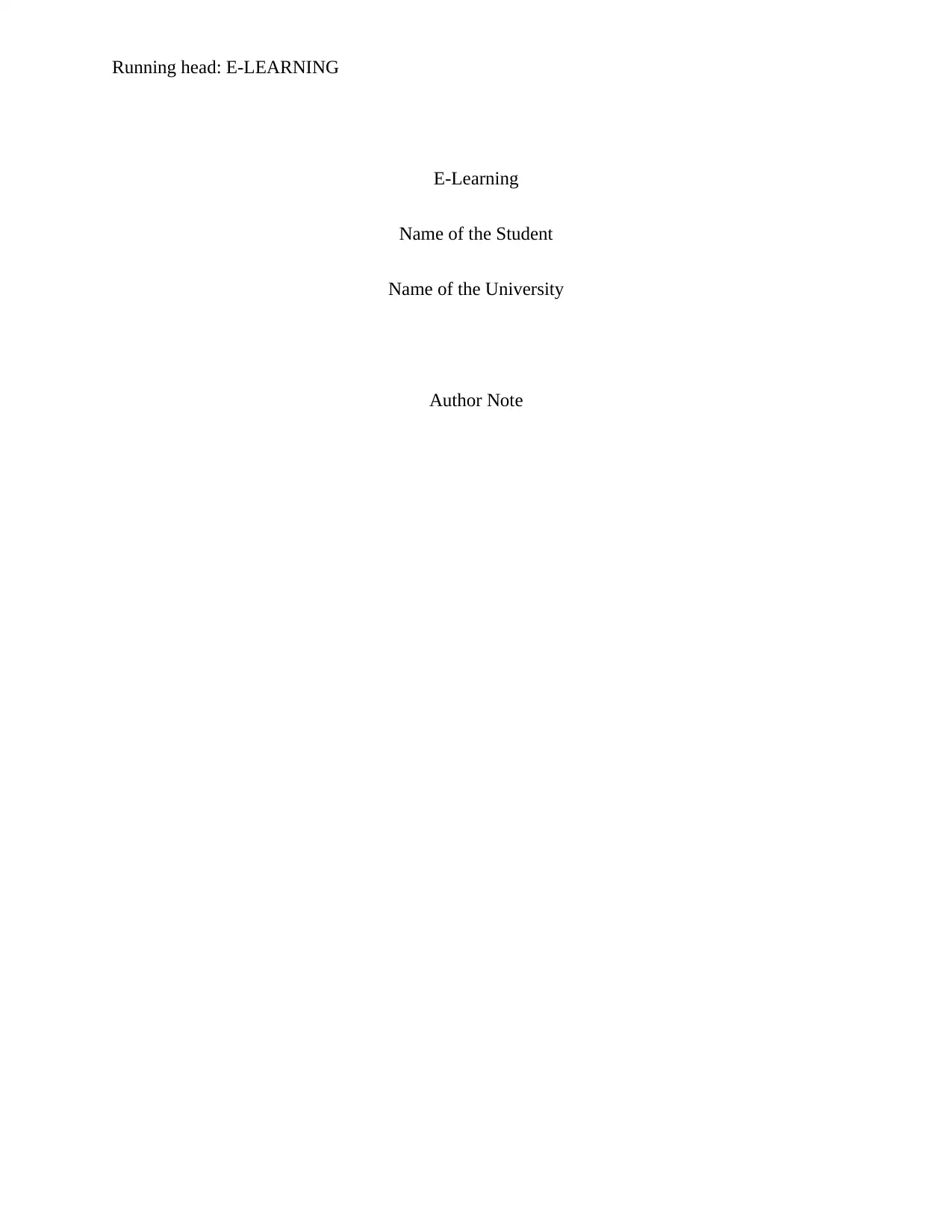
Running head: E-LEARNING
E-Learning
Name of the Student
Name of the University
Author Note
E-Learning
Name of the Student
Name of the University
Author Note
Paraphrase This Document
Need a fresh take? Get an instant paraphrase of this document with our AI Paraphraser
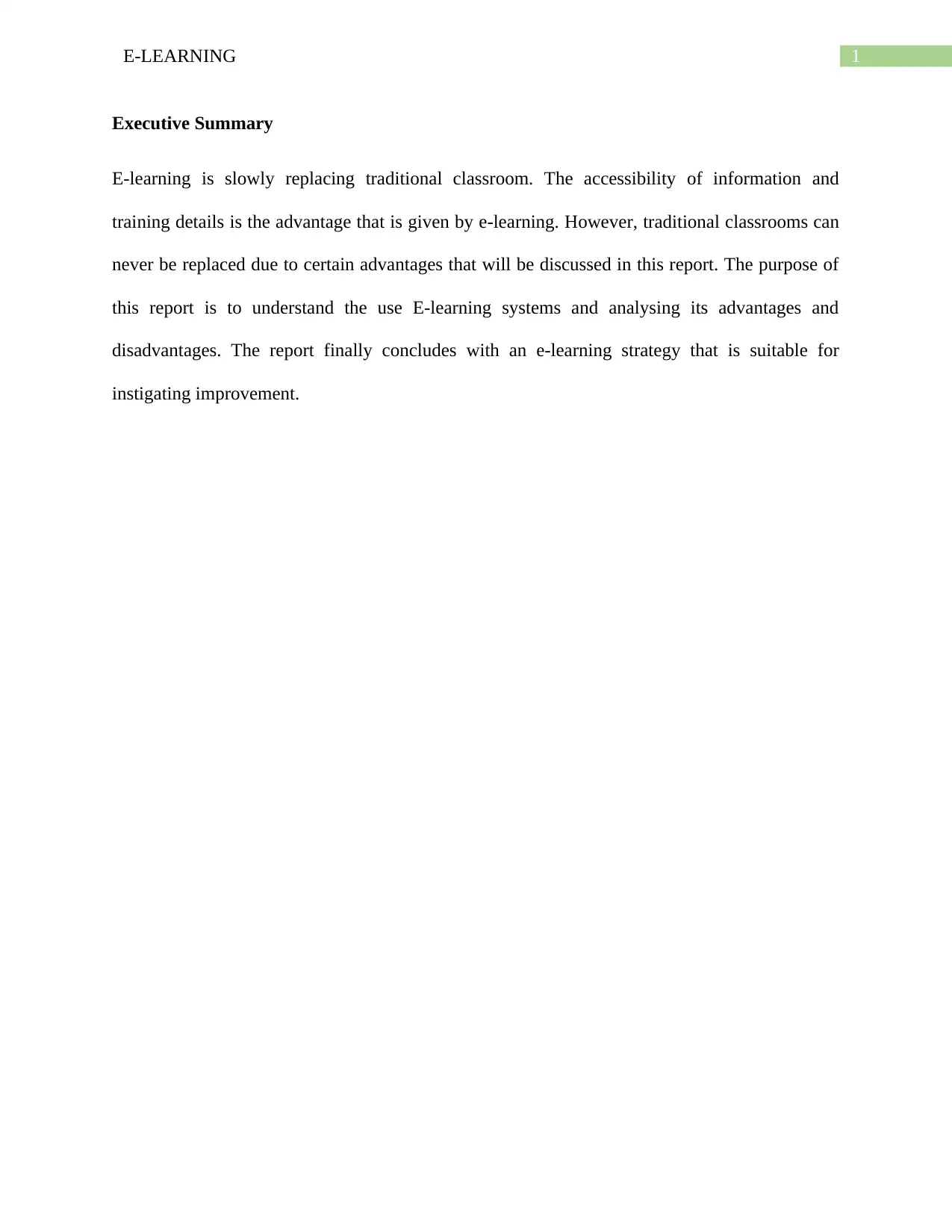
1E-LEARNING
Executive Summary
E-learning is slowly replacing traditional classroom. The accessibility of information and
training details is the advantage that is given by e-learning. However, traditional classrooms can
never be replaced due to certain advantages that will be discussed in this report. The purpose of
this report is to understand the use E-learning systems and analysing its advantages and
disadvantages. The report finally concludes with an e-learning strategy that is suitable for
instigating improvement.
Executive Summary
E-learning is slowly replacing traditional classroom. The accessibility of information and
training details is the advantage that is given by e-learning. However, traditional classrooms can
never be replaced due to certain advantages that will be discussed in this report. The purpose of
this report is to understand the use E-learning systems and analysing its advantages and
disadvantages. The report finally concludes with an e-learning strategy that is suitable for
instigating improvement.
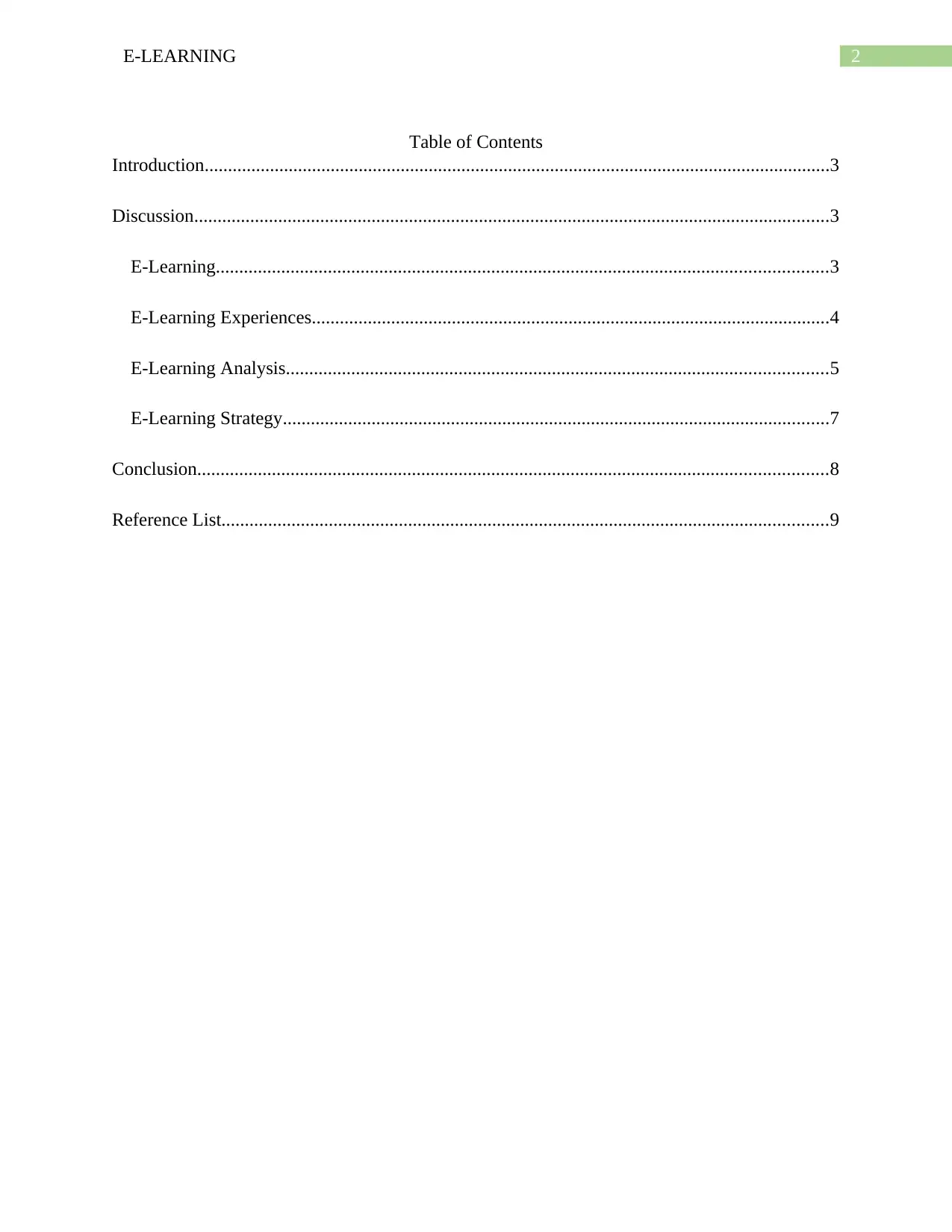
2E-LEARNING
Table of Contents
Introduction......................................................................................................................................3
Discussion........................................................................................................................................3
E-Learning...................................................................................................................................3
E-Learning Experiences...............................................................................................................4
E-Learning Analysis....................................................................................................................5
E-Learning Strategy.....................................................................................................................7
Conclusion.......................................................................................................................................8
Reference List..................................................................................................................................9
Table of Contents
Introduction......................................................................................................................................3
Discussion........................................................................................................................................3
E-Learning...................................................................................................................................3
E-Learning Experiences...............................................................................................................4
E-Learning Analysis....................................................................................................................5
E-Learning Strategy.....................................................................................................................7
Conclusion.......................................................................................................................................8
Reference List..................................................................................................................................9
⊘ This is a preview!⊘
Do you want full access?
Subscribe today to unlock all pages.

Trusted by 1+ million students worldwide
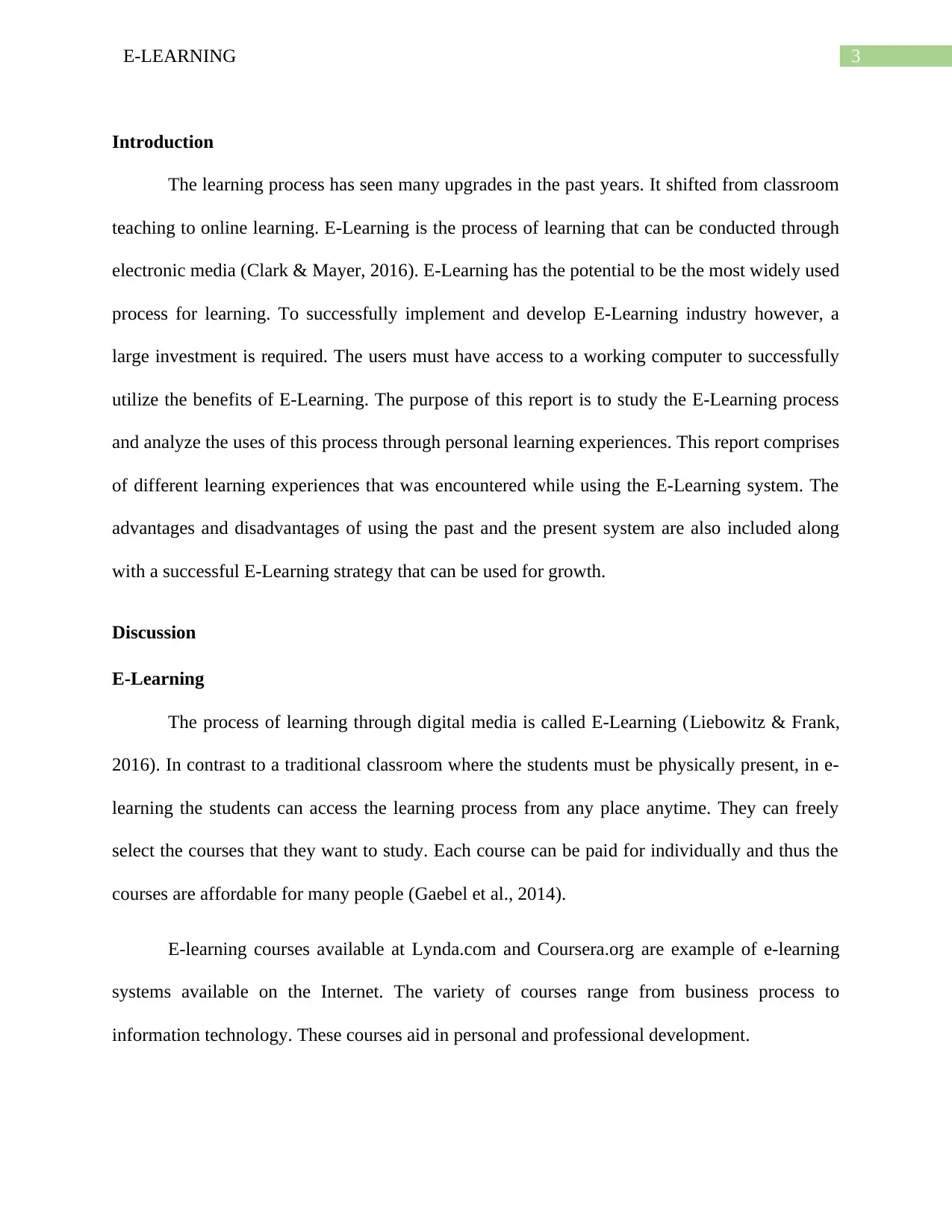
3E-LEARNING
Introduction
The learning process has seen many upgrades in the past years. It shifted from classroom
teaching to online learning. E-Learning is the process of learning that can be conducted through
electronic media (Clark & Mayer, 2016). E-Learning has the potential to be the most widely used
process for learning. To successfully implement and develop E-Learning industry however, a
large investment is required. The users must have access to a working computer to successfully
utilize the benefits of E-Learning. The purpose of this report is to study the E-Learning process
and analyze the uses of this process through personal learning experiences. This report comprises
of different learning experiences that was encountered while using the E-Learning system. The
advantages and disadvantages of using the past and the present system are also included along
with a successful E-Learning strategy that can be used for growth.
Discussion
E-Learning
The process of learning through digital media is called E-Learning (Liebowitz & Frank,
2016). In contrast to a traditional classroom where the students must be physically present, in e-
learning the students can access the learning process from any place anytime. They can freely
select the courses that they want to study. Each course can be paid for individually and thus the
courses are affordable for many people (Gaebel et al., 2014).
E-learning courses available at Lynda.com and Coursera.org are example of e-learning
systems available on the Internet. The variety of courses range from business process to
information technology. These courses aid in personal and professional development.
Introduction
The learning process has seen many upgrades in the past years. It shifted from classroom
teaching to online learning. E-Learning is the process of learning that can be conducted through
electronic media (Clark & Mayer, 2016). E-Learning has the potential to be the most widely used
process for learning. To successfully implement and develop E-Learning industry however, a
large investment is required. The users must have access to a working computer to successfully
utilize the benefits of E-Learning. The purpose of this report is to study the E-Learning process
and analyze the uses of this process through personal learning experiences. This report comprises
of different learning experiences that was encountered while using the E-Learning system. The
advantages and disadvantages of using the past and the present system are also included along
with a successful E-Learning strategy that can be used for growth.
Discussion
E-Learning
The process of learning through digital media is called E-Learning (Liebowitz & Frank,
2016). In contrast to a traditional classroom where the students must be physically present, in e-
learning the students can access the learning process from any place anytime. They can freely
select the courses that they want to study. Each course can be paid for individually and thus the
courses are affordable for many people (Gaebel et al., 2014).
E-learning courses available at Lynda.com and Coursera.org are example of e-learning
systems available on the Internet. The variety of courses range from business process to
information technology. These courses aid in personal and professional development.
Paraphrase This Document
Need a fresh take? Get an instant paraphrase of this document with our AI Paraphraser
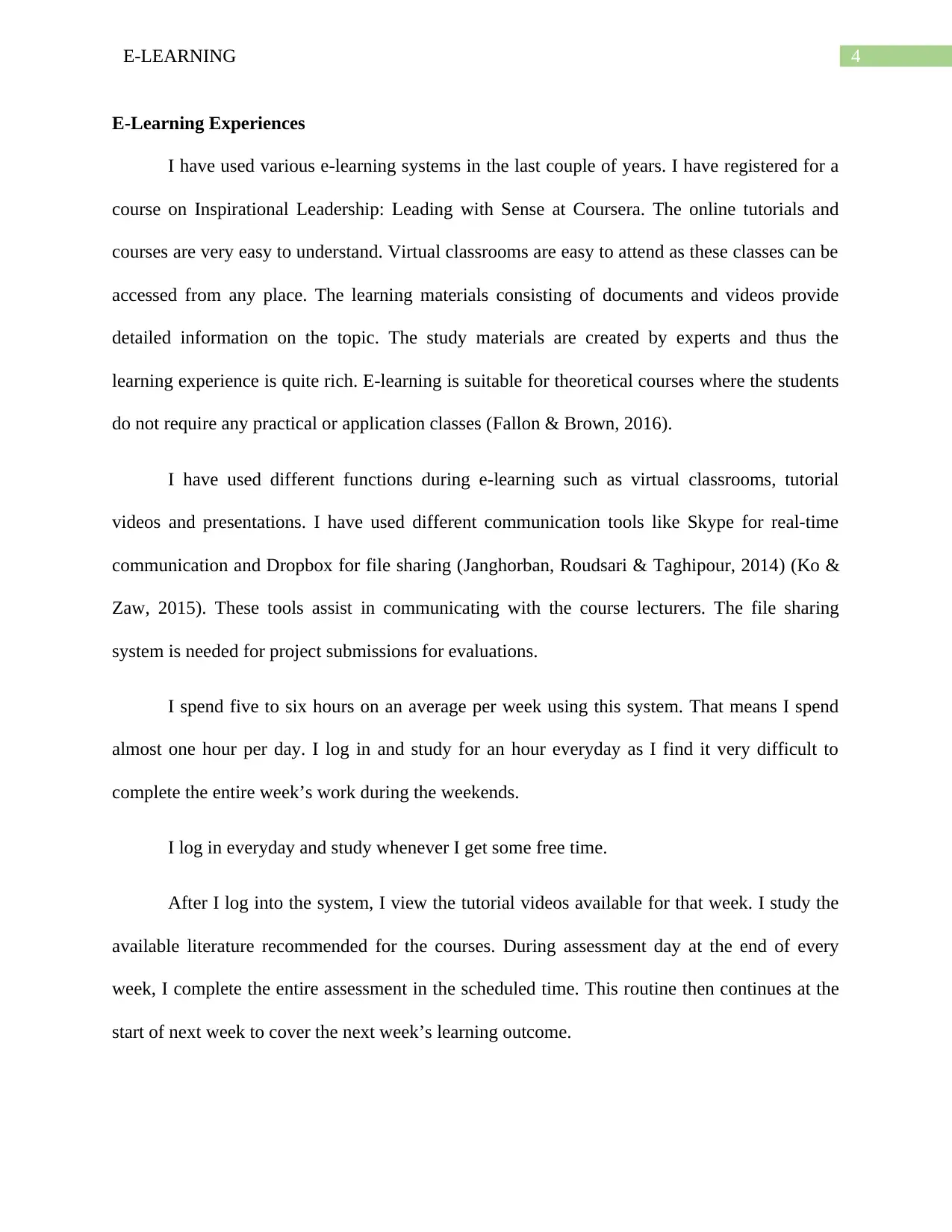
4E-LEARNING
E-Learning Experiences
I have used various e-learning systems in the last couple of years. I have registered for a
course on Inspirational Leadership: Leading with Sense at Coursera. The online tutorials and
courses are very easy to understand. Virtual classrooms are easy to attend as these classes can be
accessed from any place. The learning materials consisting of documents and videos provide
detailed information on the topic. The study materials are created by experts and thus the
learning experience is quite rich. E-learning is suitable for theoretical courses where the students
do not require any practical or application classes (Fallon & Brown, 2016).
I have used different functions during e-learning such as virtual classrooms, tutorial
videos and presentations. I have used different communication tools like Skype for real-time
communication and Dropbox for file sharing (Janghorban, Roudsari & Taghipour, 2014) (Ko &
Zaw, 2015). These tools assist in communicating with the course lecturers. The file sharing
system is needed for project submissions for evaluations.
I spend five to six hours on an average per week using this system. That means I spend
almost one hour per day. I log in and study for an hour everyday as I find it very difficult to
complete the entire week’s work during the weekends.
I log in everyday and study whenever I get some free time.
After I log into the system, I view the tutorial videos available for that week. I study the
available literature recommended for the courses. During assessment day at the end of every
week, I complete the entire assessment in the scheduled time. This routine then continues at the
start of next week to cover the next week’s learning outcome.
E-Learning Experiences
I have used various e-learning systems in the last couple of years. I have registered for a
course on Inspirational Leadership: Leading with Sense at Coursera. The online tutorials and
courses are very easy to understand. Virtual classrooms are easy to attend as these classes can be
accessed from any place. The learning materials consisting of documents and videos provide
detailed information on the topic. The study materials are created by experts and thus the
learning experience is quite rich. E-learning is suitable for theoretical courses where the students
do not require any practical or application classes (Fallon & Brown, 2016).
I have used different functions during e-learning such as virtual classrooms, tutorial
videos and presentations. I have used different communication tools like Skype for real-time
communication and Dropbox for file sharing (Janghorban, Roudsari & Taghipour, 2014) (Ko &
Zaw, 2015). These tools assist in communicating with the course lecturers. The file sharing
system is needed for project submissions for evaluations.
I spend five to six hours on an average per week using this system. That means I spend
almost one hour per day. I log in and study for an hour everyday as I find it very difficult to
complete the entire week’s work during the weekends.
I log in everyday and study whenever I get some free time.
After I log into the system, I view the tutorial videos available for that week. I study the
available literature recommended for the courses. During assessment day at the end of every
week, I complete the entire assessment in the scheduled time. This routine then continues at the
start of next week to cover the next week’s learning outcome.
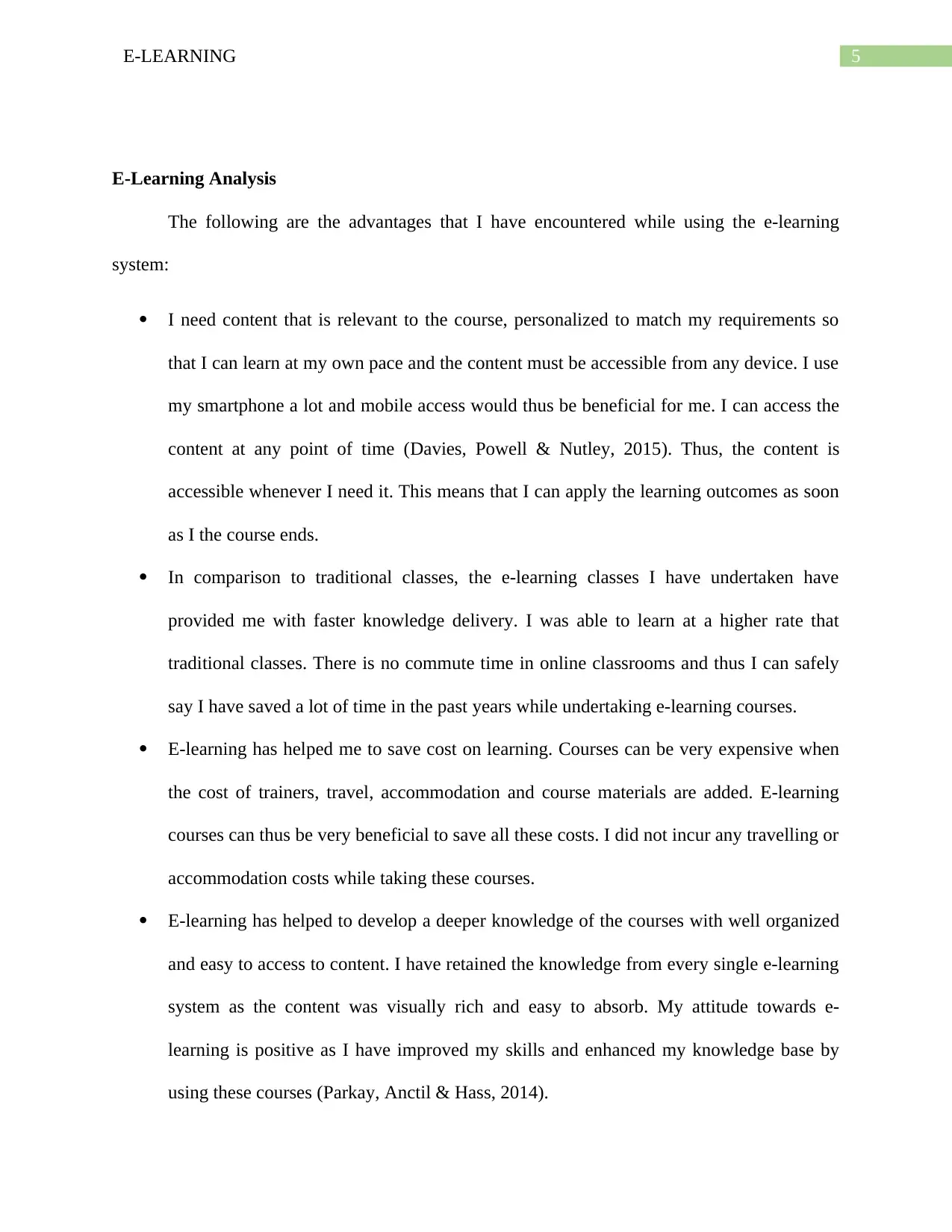
5E-LEARNING
E-Learning Analysis
The following are the advantages that I have encountered while using the e-learning
system:
I need content that is relevant to the course, personalized to match my requirements so
that I can learn at my own pace and the content must be accessible from any device. I use
my smartphone a lot and mobile access would thus be beneficial for me. I can access the
content at any point of time (Davies, Powell & Nutley, 2015). Thus, the content is
accessible whenever I need it. This means that I can apply the learning outcomes as soon
as I the course ends.
In comparison to traditional classes, the e-learning classes I have undertaken have
provided me with faster knowledge delivery. I was able to learn at a higher rate that
traditional classes. There is no commute time in online classrooms and thus I can safely
say I have saved a lot of time in the past years while undertaking e-learning courses.
E-learning has helped me to save cost on learning. Courses can be very expensive when
the cost of trainers, travel, accommodation and course materials are added. E-learning
courses can thus be very beneficial to save all these costs. I did not incur any travelling or
accommodation costs while taking these courses.
E-learning has helped to develop a deeper knowledge of the courses with well organized
and easy to access to content. I have retained the knowledge from every single e-learning
system as the content was visually rich and easy to absorb. My attitude towards e-
learning is positive as I have improved my skills and enhanced my knowledge base by
using these courses (Parkay, Anctil & Hass, 2014).
E-Learning Analysis
The following are the advantages that I have encountered while using the e-learning
system:
I need content that is relevant to the course, personalized to match my requirements so
that I can learn at my own pace and the content must be accessible from any device. I use
my smartphone a lot and mobile access would thus be beneficial for me. I can access the
content at any point of time (Davies, Powell & Nutley, 2015). Thus, the content is
accessible whenever I need it. This means that I can apply the learning outcomes as soon
as I the course ends.
In comparison to traditional classes, the e-learning classes I have undertaken have
provided me with faster knowledge delivery. I was able to learn at a higher rate that
traditional classes. There is no commute time in online classrooms and thus I can safely
say I have saved a lot of time in the past years while undertaking e-learning courses.
E-learning has helped me to save cost on learning. Courses can be very expensive when
the cost of trainers, travel, accommodation and course materials are added. E-learning
courses can thus be very beneficial to save all these costs. I did not incur any travelling or
accommodation costs while taking these courses.
E-learning has helped to develop a deeper knowledge of the courses with well organized
and easy to access to content. I have retained the knowledge from every single e-learning
system as the content was visually rich and easy to absorb. My attitude towards e-
learning is positive as I have improved my skills and enhanced my knowledge base by
using these courses (Parkay, Anctil & Hass, 2014).
⊘ This is a preview!⊘
Do you want full access?
Subscribe today to unlock all pages.

Trusted by 1+ million students worldwide
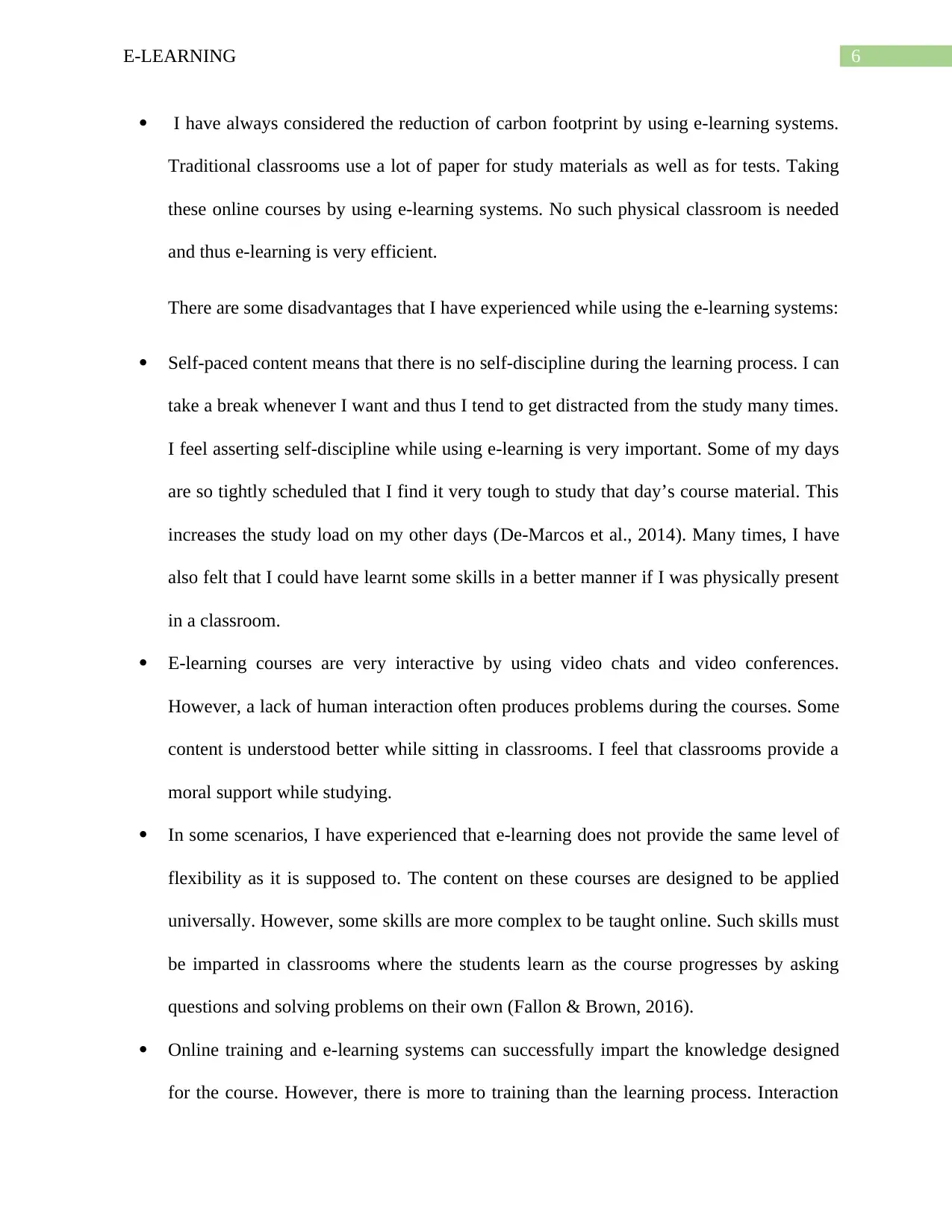
6E-LEARNING
I have always considered the reduction of carbon footprint by using e-learning systems.
Traditional classrooms use a lot of paper for study materials as well as for tests. Taking
these online courses by using e-learning systems. No such physical classroom is needed
and thus e-learning is very efficient.
There are some disadvantages that I have experienced while using the e-learning systems:
Self-paced content means that there is no self-discipline during the learning process. I can
take a break whenever I want and thus I tend to get distracted from the study many times.
I feel asserting self-discipline while using e-learning is very important. Some of my days
are so tightly scheduled that I find it very tough to study that day’s course material. This
increases the study load on my other days (De-Marcos et al., 2014). Many times, I have
also felt that I could have learnt some skills in a better manner if I was physically present
in a classroom.
E-learning courses are very interactive by using video chats and video conferences.
However, a lack of human interaction often produces problems during the courses. Some
content is understood better while sitting in classrooms. I feel that classrooms provide a
moral support while studying.
In some scenarios, I have experienced that e-learning does not provide the same level of
flexibility as it is supposed to. The content on these courses are designed to be applied
universally. However, some skills are more complex to be taught online. Such skills must
be imparted in classrooms where the students learn as the course progresses by asking
questions and solving problems on their own (Fallon & Brown, 2016).
Online training and e-learning systems can successfully impart the knowledge designed
for the course. However, there is more to training than the learning process. Interaction
I have always considered the reduction of carbon footprint by using e-learning systems.
Traditional classrooms use a lot of paper for study materials as well as for tests. Taking
these online courses by using e-learning systems. No such physical classroom is needed
and thus e-learning is very efficient.
There are some disadvantages that I have experienced while using the e-learning systems:
Self-paced content means that there is no self-discipline during the learning process. I can
take a break whenever I want and thus I tend to get distracted from the study many times.
I feel asserting self-discipline while using e-learning is very important. Some of my days
are so tightly scheduled that I find it very tough to study that day’s course material. This
increases the study load on my other days (De-Marcos et al., 2014). Many times, I have
also felt that I could have learnt some skills in a better manner if I was physically present
in a classroom.
E-learning courses are very interactive by using video chats and video conferences.
However, a lack of human interaction often produces problems during the courses. Some
content is understood better while sitting in classrooms. I feel that classrooms provide a
moral support while studying.
In some scenarios, I have experienced that e-learning does not provide the same level of
flexibility as it is supposed to. The content on these courses are designed to be applied
universally. However, some skills are more complex to be taught online. Such skills must
be imparted in classrooms where the students learn as the course progresses by asking
questions and solving problems on their own (Fallon & Brown, 2016).
Online training and e-learning systems can successfully impart the knowledge designed
for the course. However, there is more to training than the learning process. Interaction
Paraphrase This Document
Need a fresh take? Get an instant paraphrase of this document with our AI Paraphraser
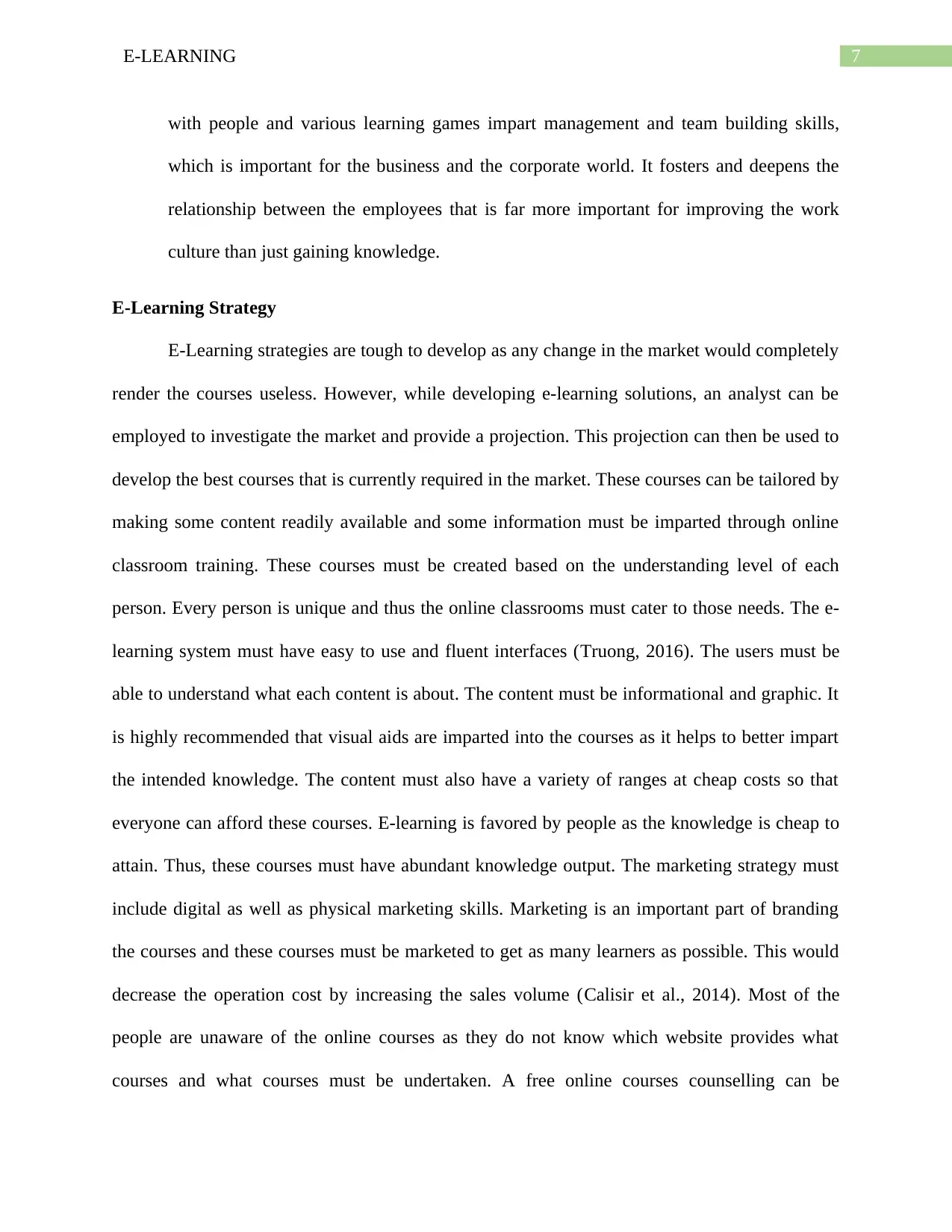
7E-LEARNING
with people and various learning games impart management and team building skills,
which is important for the business and the corporate world. It fosters and deepens the
relationship between the employees that is far more important for improving the work
culture than just gaining knowledge.
E-Learning Strategy
E-Learning strategies are tough to develop as any change in the market would completely
render the courses useless. However, while developing e-learning solutions, an analyst can be
employed to investigate the market and provide a projection. This projection can then be used to
develop the best courses that is currently required in the market. These courses can be tailored by
making some content readily available and some information must be imparted through online
classroom training. These courses must be created based on the understanding level of each
person. Every person is unique and thus the online classrooms must cater to those needs. The e-
learning system must have easy to use and fluent interfaces (Truong, 2016). The users must be
able to understand what each content is about. The content must be informational and graphic. It
is highly recommended that visual aids are imparted into the courses as it helps to better impart
the intended knowledge. The content must also have a variety of ranges at cheap costs so that
everyone can afford these courses. E-learning is favored by people as the knowledge is cheap to
attain. Thus, these courses must have abundant knowledge output. The marketing strategy must
include digital as well as physical marketing skills. Marketing is an important part of branding
the courses and these courses must be marketed to get as many learners as possible. This would
decrease the operation cost by increasing the sales volume (Calisir et al., 2014). Most of the
people are unaware of the online courses as they do not know which website provides what
courses and what courses must be undertaken. A free online courses counselling can be
with people and various learning games impart management and team building skills,
which is important for the business and the corporate world. It fosters and deepens the
relationship between the employees that is far more important for improving the work
culture than just gaining knowledge.
E-Learning Strategy
E-Learning strategies are tough to develop as any change in the market would completely
render the courses useless. However, while developing e-learning solutions, an analyst can be
employed to investigate the market and provide a projection. This projection can then be used to
develop the best courses that is currently required in the market. These courses can be tailored by
making some content readily available and some information must be imparted through online
classroom training. These courses must be created based on the understanding level of each
person. Every person is unique and thus the online classrooms must cater to those needs. The e-
learning system must have easy to use and fluent interfaces (Truong, 2016). The users must be
able to understand what each content is about. The content must be informational and graphic. It
is highly recommended that visual aids are imparted into the courses as it helps to better impart
the intended knowledge. The content must also have a variety of ranges at cheap costs so that
everyone can afford these courses. E-learning is favored by people as the knowledge is cheap to
attain. Thus, these courses must have abundant knowledge output. The marketing strategy must
include digital as well as physical marketing skills. Marketing is an important part of branding
the courses and these courses must be marketed to get as many learners as possible. This would
decrease the operation cost by increasing the sales volume (Calisir et al., 2014). Most of the
people are unaware of the online courses as they do not know which website provides what
courses and what courses must be undertaken. A free online courses counselling can be
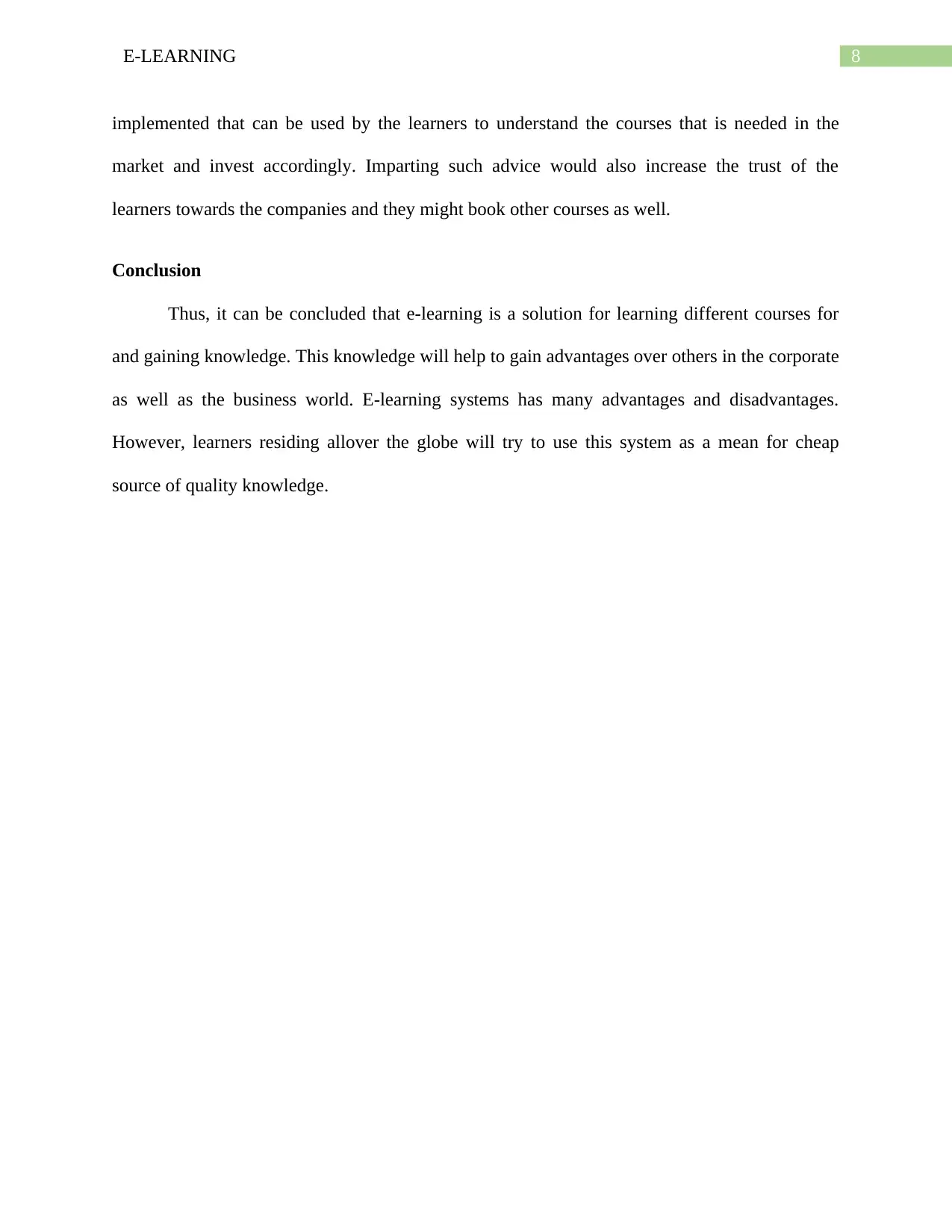
8E-LEARNING
implemented that can be used by the learners to understand the courses that is needed in the
market and invest accordingly. Imparting such advice would also increase the trust of the
learners towards the companies and they might book other courses as well.
Conclusion
Thus, it can be concluded that e-learning is a solution for learning different courses for
and gaining knowledge. This knowledge will help to gain advantages over others in the corporate
as well as the business world. E-learning systems has many advantages and disadvantages.
However, learners residing allover the globe will try to use this system as a mean for cheap
source of quality knowledge.
implemented that can be used by the learners to understand the courses that is needed in the
market and invest accordingly. Imparting such advice would also increase the trust of the
learners towards the companies and they might book other courses as well.
Conclusion
Thus, it can be concluded that e-learning is a solution for learning different courses for
and gaining knowledge. This knowledge will help to gain advantages over others in the corporate
as well as the business world. E-learning systems has many advantages and disadvantages.
However, learners residing allover the globe will try to use this system as a mean for cheap
source of quality knowledge.
⊘ This is a preview!⊘
Do you want full access?
Subscribe today to unlock all pages.

Trusted by 1+ million students worldwide
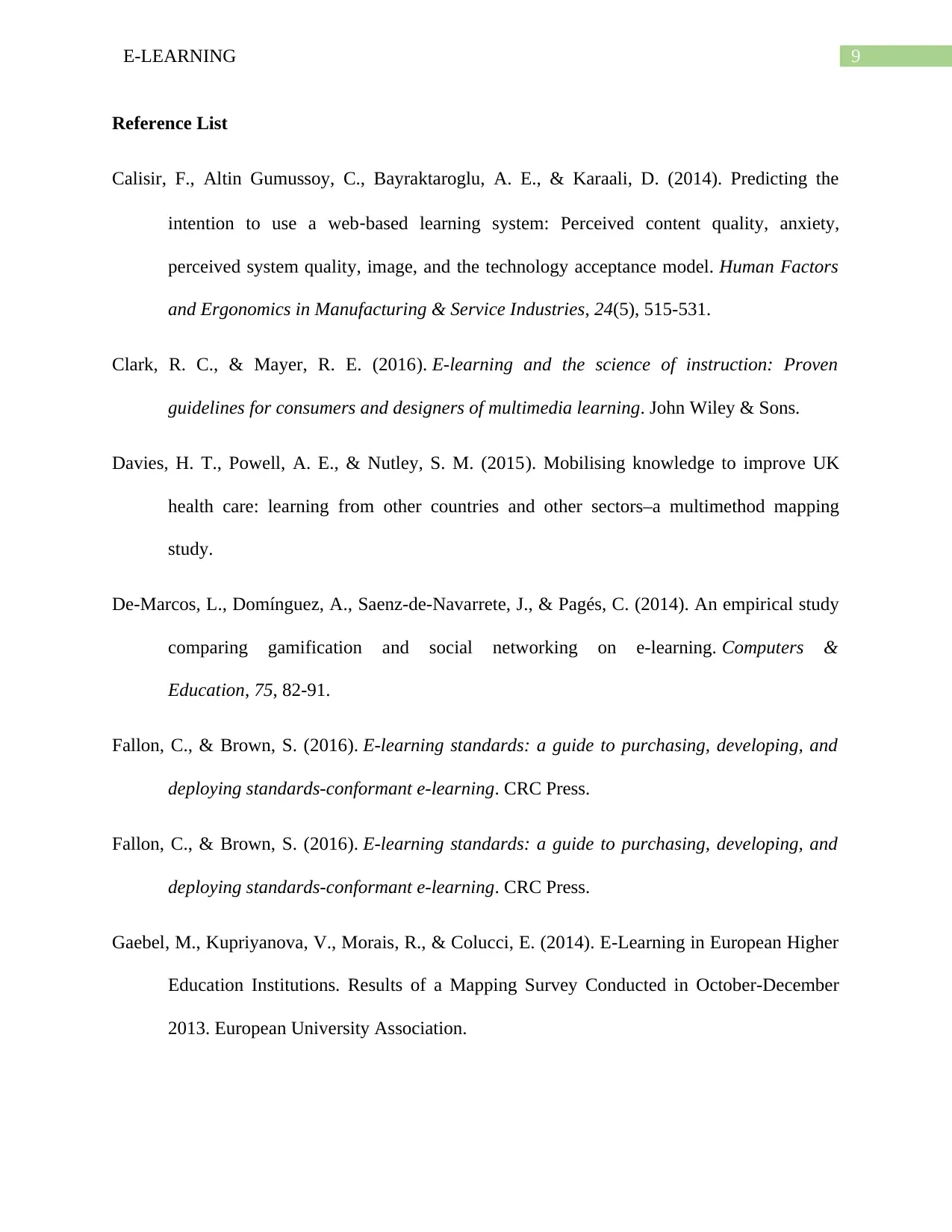
9E-LEARNING
Reference List
Calisir, F., Altin Gumussoy, C., Bayraktaroglu, A. E., & Karaali, D. (2014). Predicting the
intention to use a web‐based learning system: Perceived content quality, anxiety,
perceived system quality, image, and the technology acceptance model. Human Factors
and Ergonomics in Manufacturing & Service Industries, 24(5), 515-531.
Clark, R. C., & Mayer, R. E. (2016). E-learning and the science of instruction: Proven
guidelines for consumers and designers of multimedia learning. John Wiley & Sons.
Davies, H. T., Powell, A. E., & Nutley, S. M. (2015). Mobilising knowledge to improve UK
health care: learning from other countries and other sectors–a multimethod mapping
study.
De-Marcos, L., Domínguez, A., Saenz-de-Navarrete, J., & Pagés, C. (2014). An empirical study
comparing gamification and social networking on e-learning. Computers &
Education, 75, 82-91.
Fallon, C., & Brown, S. (2016). E-learning standards: a guide to purchasing, developing, and
deploying standards-conformant e-learning. CRC Press.
Fallon, C., & Brown, S. (2016). E-learning standards: a guide to purchasing, developing, and
deploying standards-conformant e-learning. CRC Press.
Gaebel, M., Kupriyanova, V., Morais, R., & Colucci, E. (2014). E-Learning in European Higher
Education Institutions. Results of a Mapping Survey Conducted in October-December
2013. European University Association.
Reference List
Calisir, F., Altin Gumussoy, C., Bayraktaroglu, A. E., & Karaali, D. (2014). Predicting the
intention to use a web‐based learning system: Perceived content quality, anxiety,
perceived system quality, image, and the technology acceptance model. Human Factors
and Ergonomics in Manufacturing & Service Industries, 24(5), 515-531.
Clark, R. C., & Mayer, R. E. (2016). E-learning and the science of instruction: Proven
guidelines for consumers and designers of multimedia learning. John Wiley & Sons.
Davies, H. T., Powell, A. E., & Nutley, S. M. (2015). Mobilising knowledge to improve UK
health care: learning from other countries and other sectors–a multimethod mapping
study.
De-Marcos, L., Domínguez, A., Saenz-de-Navarrete, J., & Pagés, C. (2014). An empirical study
comparing gamification and social networking on e-learning. Computers &
Education, 75, 82-91.
Fallon, C., & Brown, S. (2016). E-learning standards: a guide to purchasing, developing, and
deploying standards-conformant e-learning. CRC Press.
Fallon, C., & Brown, S. (2016). E-learning standards: a guide to purchasing, developing, and
deploying standards-conformant e-learning. CRC Press.
Gaebel, M., Kupriyanova, V., Morais, R., & Colucci, E. (2014). E-Learning in European Higher
Education Institutions. Results of a Mapping Survey Conducted in October-December
2013. European University Association.
Paraphrase This Document
Need a fresh take? Get an instant paraphrase of this document with our AI Paraphraser
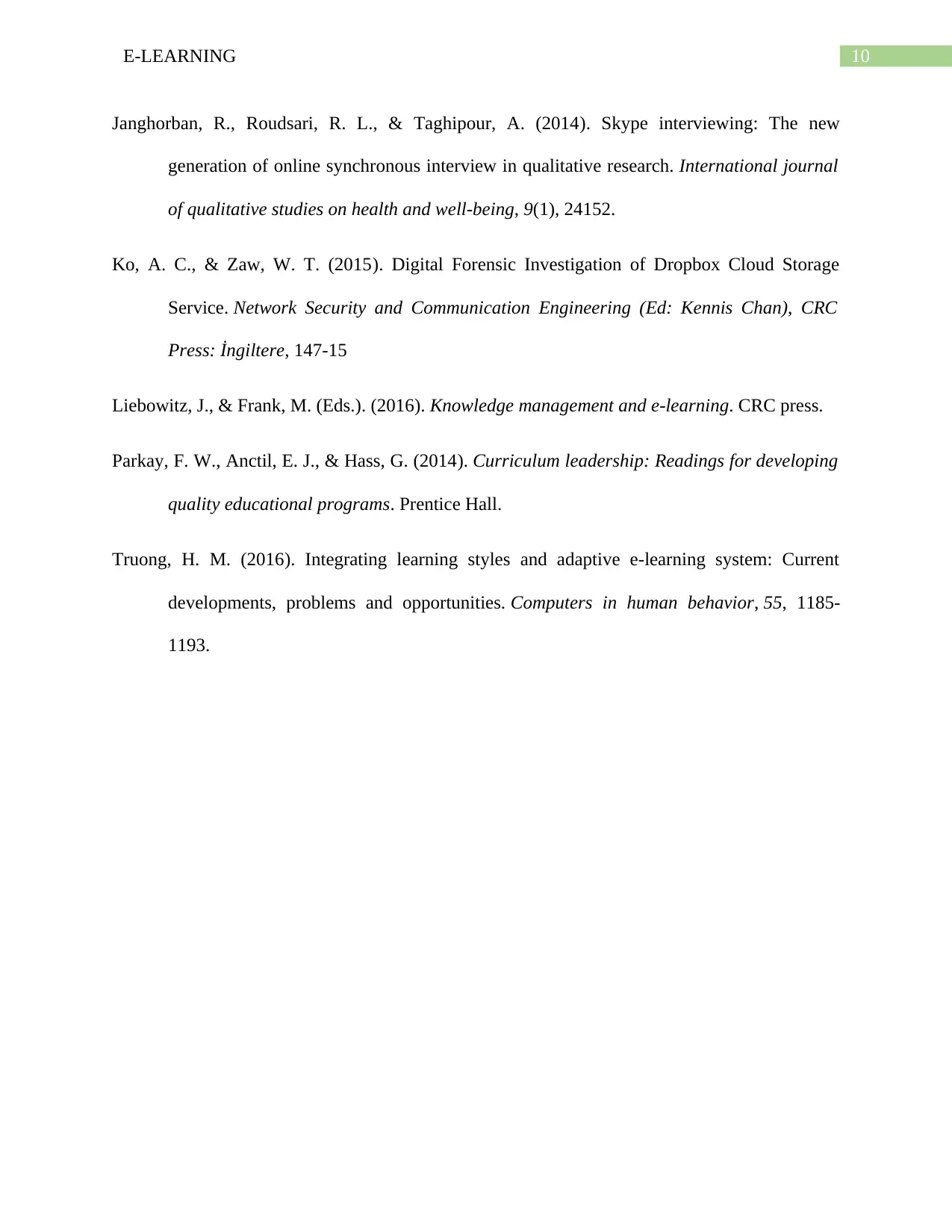
10E-LEARNING
Janghorban, R., Roudsari, R. L., & Taghipour, A. (2014). Skype interviewing: The new
generation of online synchronous interview in qualitative research. International journal
of qualitative studies on health and well-being, 9(1), 24152.
Ko, A. C., & Zaw, W. T. (2015). Digital Forensic Investigation of Dropbox Cloud Storage
Service. Network Security and Communication Engineering (Ed: Kennis Chan), CRC
Press: İngiltere, 147-15
Liebowitz, J., & Frank, M. (Eds.). (2016). Knowledge management and e-learning. CRC press.
Parkay, F. W., Anctil, E. J., & Hass, G. (2014). Curriculum leadership: Readings for developing
quality educational programs. Prentice Hall.
Truong, H. M. (2016). Integrating learning styles and adaptive e-learning system: Current
developments, problems and opportunities. Computers in human behavior, 55, 1185-
1193.
Janghorban, R., Roudsari, R. L., & Taghipour, A. (2014). Skype interviewing: The new
generation of online synchronous interview in qualitative research. International journal
of qualitative studies on health and well-being, 9(1), 24152.
Ko, A. C., & Zaw, W. T. (2015). Digital Forensic Investigation of Dropbox Cloud Storage
Service. Network Security and Communication Engineering (Ed: Kennis Chan), CRC
Press: İngiltere, 147-15
Liebowitz, J., & Frank, M. (Eds.). (2016). Knowledge management and e-learning. CRC press.
Parkay, F. W., Anctil, E. J., & Hass, G. (2014). Curriculum leadership: Readings for developing
quality educational programs. Prentice Hall.
Truong, H. M. (2016). Integrating learning styles and adaptive e-learning system: Current
developments, problems and opportunities. Computers in human behavior, 55, 1185-
1193.
1 out of 11
Related Documents
Your All-in-One AI-Powered Toolkit for Academic Success.
+13062052269
info@desklib.com
Available 24*7 on WhatsApp / Email
![[object Object]](/_next/static/media/star-bottom.7253800d.svg)
Unlock your academic potential
Copyright © 2020–2025 A2Z Services. All Rights Reserved. Developed and managed by ZUCOL.


![A Study on Flipped Classroom Implementation at [School Name]](/_next/image/?url=https%3A%2F%2Fdesklib.com%2Fmedia%2Fimages%2Fsc%2Fccace13048cb4bb49422aeeef0a235b4.jpg&w=256&q=75)
